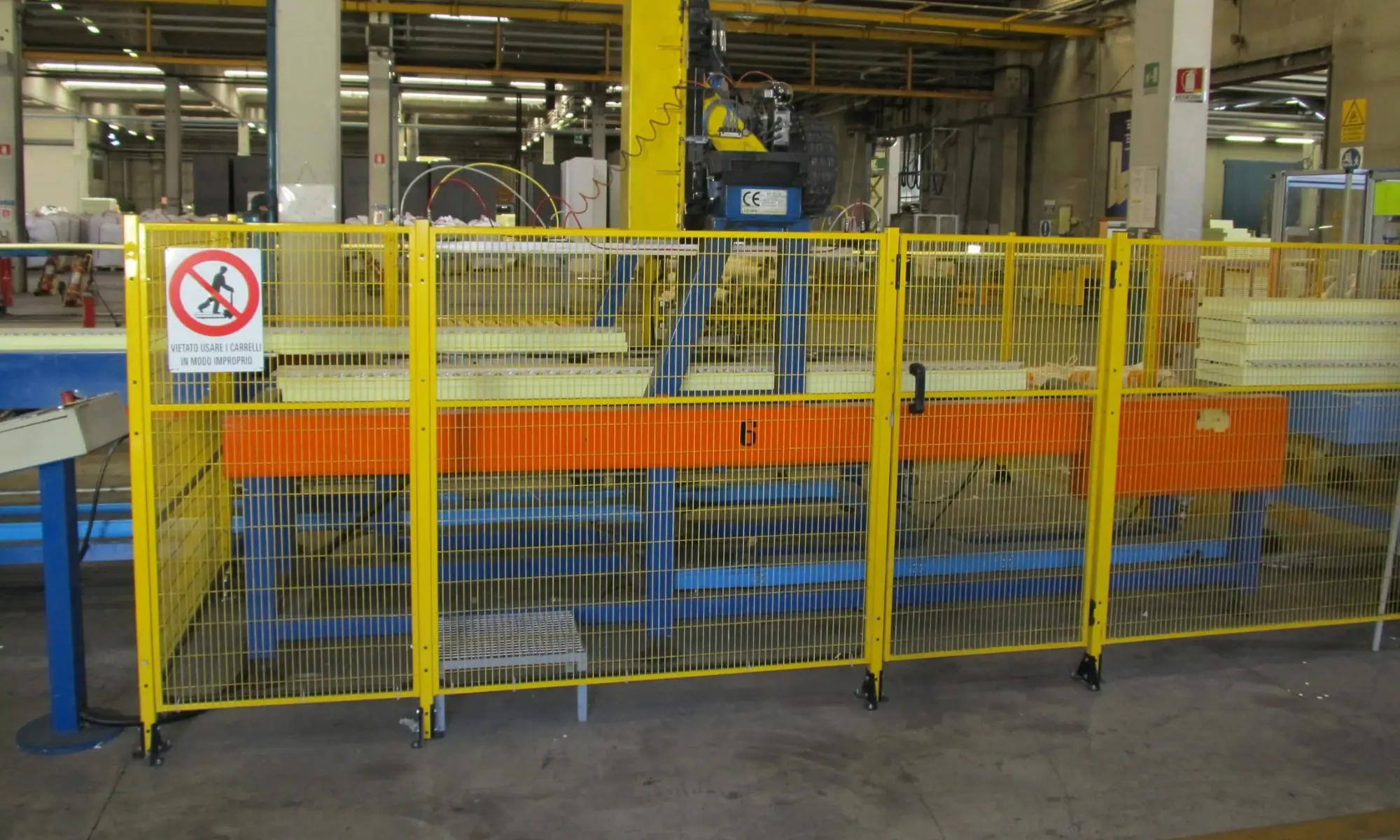Safety is no joke in the world of whirring machines and industrial robots – but that doesn’t mean we can’t talk about it with a smile. Enter interlocked guards, the loyal bouncers of the machine world. These safety devices make sure dangerous equipment minds its manners by shutting down or refusing to start when a protective gate or cover isn’t properly closed. The result? Fewer accidents, happier safety officers, and machinery that only runs when it’s safe to do so.
In this article, we’ll explore what interlocked guards are, how they work, the different types available, and the benefits they bring. We’ll also look at common places you’ll find interlocked guards – from factory floors to futuristic robots – and peek at some cool new innovations (RFID gadgets and smart interlocks!) that are making these safety systems even better. Let’s dive in, and remember: staying safe is always in style, even with a bit of humor on the side.
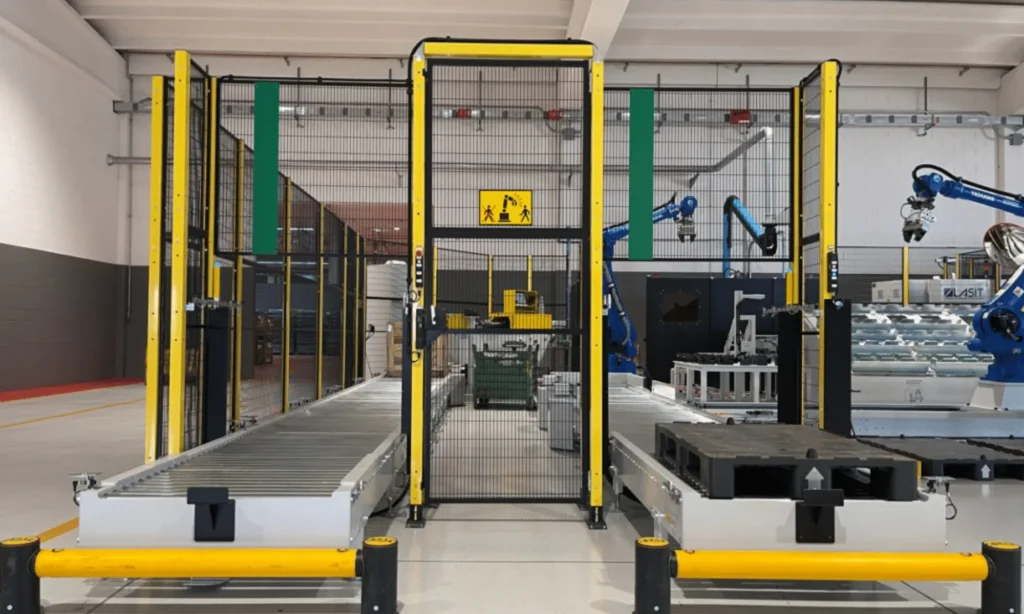
What Are Interlocked Guards?
Interlocked guards are a type of machine safeguarding system designed to protect people from the dangerous parts of equipment. In simple terms, an interlocked guard is a physical barrier (like a door, gate, or removable cover) that is connected to the machine’s control system. If the guard is opened or removed, it tells the machine to stop or not to start in the first place.
Conversely, the machine only operates when the guard is closed and all safety conditions are met. This interconnection – or interlock – prevents you from, say, sticking your hand into a running machine (never a good idea!) by making sure the machine can’t run unless the protective guard is in place. Importantly, just closing the guard doesn’t automatically restart the machine; you’d still need to start it normally once everything is secure.
In essence, interlocked guards create a safe working environment by linking machine operation with the status of protective barriers. They are common in modern factories and are often required by safety standards to minimize the risk of accidents.

How Do Interlocked Guards Work?
Think of an interlocked guard like a smart safety gate with a direct line to your machine’s brain. Here’s a simple rundown of how they operate:
1. Sensing the Guard (and the People)
The system uses sensors or switches to detect whether the guard is closed or open, and sometimes even to sense if a person is in a dangerous area. For example, a tiny switch might be pressed when a door is closed, or a light beam (light curtain) might monitor an opening. These safety sensors feed information to a controller.
2. Stopping and Starting the Machine Safely
The moment the guard is opened (or if a person steps where they shouldn’t), the interlock sends a signal that shuts off power or stops the machine’s moving parts. It’s as if the machine gets told, “Hey, someone’s opening the gate – cut the power!” The machine will not start (or resume) as long as the guard is open. Only when the guard is closed and everything else is safe will the control system allow the machine to be started again. This prevents dangerous situations because the machine can’t operate while you have access to the hazard area.
3. Continuous Monitoring and Feedback
A good interlock system doesn’t just act and go to sleep; it keeps an eye on things. The control unit continuously monitors the status of all guards and sensors, and it can provide feedback like indicator lights or alarms. If something isn’t right – say a guard isn’t fully latched or a sensor malfunctions – the system can alert operators or stop the machine preemptively. This is like having a vigilant safety supervisor electronically tied into the machine.
In layman’s terms, when you open the cookie jar, the cookie jar closes the kitchen – that is, opening the guard makes the machine close off its hazardous energy. Only when the “lid” (guard) is shut can the machine do its work. This smart interplay between guards and machine ensures that workers can’t get into trouble with moving machinery, intentionally or otherwise. Of course, for all this to work reliably, the interlock components need proper maintenance and testing, but we’ll stick to basics for now.
The key takeaway: an interlocked guard and a machine are best buddies that keep each other in check – if the guard isn’t in place, the machine knows it and won’t misbehave.
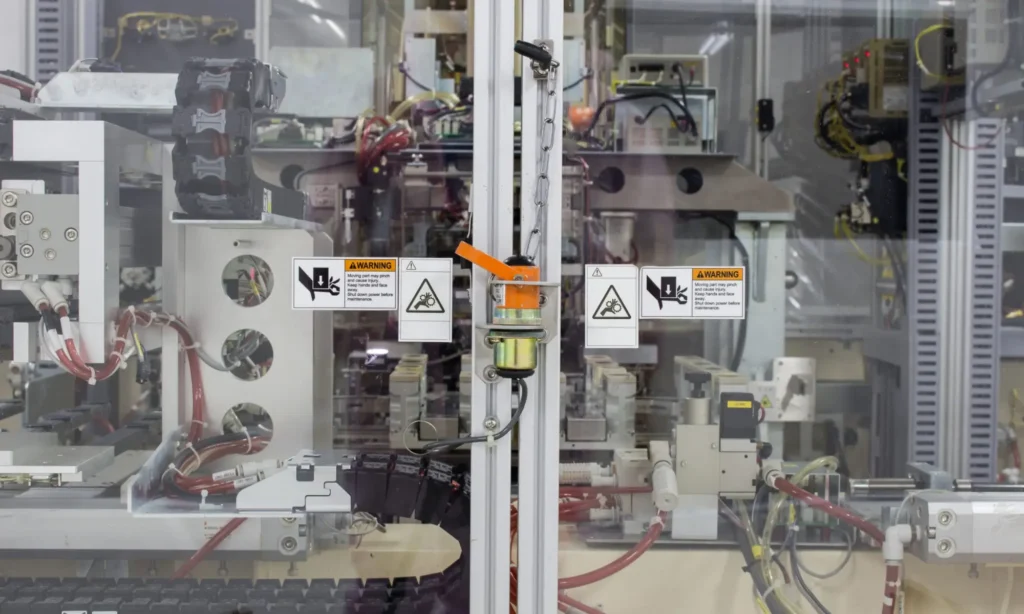
Types of Interlocked Guards
Not all interlocked guarding systems are identical – they come in a few flavors, from purely mechanical gadgets to high-tech sensor setups. Here are the common types of interlocked guards you might encounter, each working a bit differently to achieve the same safety goal:
1. Mechanical Interlocks (Trapped Key Systems)
These are oldies but goodies – purely mechanical systems using keys or mechanical links. For example, in a trapped-key interlock, you might have to remove a key from a power switch to unlock a gate; the key literally gets “trapped” in one position or the other.
The machine can only be powered on when the key is in the power switch (and not in the gate lock), ensuring the gate is closed. To open the gate, you turn off the machine and turn the key – which traps it so the power can’t be turned on while you wander into the machine. Mechanical interlocks are valued for their simplicity and durability. They don’t rely on electricity at all – great for very harsh environments or older setups – and provide a physical lockout that’s hard to cheat.
However, because they’re not “smart,” they don’t offer remote monitoring or fancy feedback. It’s basically safety by clever key tricks, and it works well in many scenarios (you’ll find these in things like conveyor access gates or older factory equipment).
2. Electrical Interlocks (Safety Switches & Sensors)
Electrical interlocks use devices like limit switches, solenoid switches, or other sensors that tie into the machine’s electrical control circuit. When you close a guarded door, a switch might be pressed or a sensor aligns, completing an electrical circuit that tells the machine “all clear.” If the guard opens, the circuit breaks and the machine immediately stops or cannot start. Common examples include safety limit switches mounted to doors, or magnetic safety switches and even light curtains (invisible beams of light that, when broken, act like an open guard).
These interlocks employ sensors or relays to detect the guard’s status and are wired into the stop/start controls. Electrical interlocks are widespread because they can be integrated into control systems relatively easily and can interface with emergency stop circuits or safety relays.
Imagine a big press machine that won’t budge unless all its panels are shut and latched – that’s electrical interlocks at work. They often allow some flexibility in design (different sensor types for different needs) and can be fail-safe (designed to default to “off” if something breaks). One thing to note: they do require proper installation and maintenance – a misaligned switch or a broken wire can disable the safety function, so regular checks are a must.
3. Physical Guard Locking Interlocks
This category overlaps with electrical interlocks but adds a physical locking mechanism. Here, a guard (say a door or gate) not only is monitored by a sensor, but is actually held shut by a lock until it’s safe to open. Often these are solenoid-operated locks or similar devices. For instance, a robotic cell might have a gate that stays locked while the robot is moving; only when the robot has stopped in a safe position will the solenoid release and allow the gate to open. This prevents someone from impatiently opening the door while inertia or hazardous motions are still winding down.
An interlock with guard locking is sometimes called a safety locking device, and it ensures you can’t even access the danger until the machine is in a safe state. This type is common on machines with run-down time (flywheels, robots, high-speed spindles) where stopping doesn’t instantaneously remove the hazard. Think of it as the double security version of an electrical interlock: it says “I won’t just turn the machine off – I’ll also keep this door shut until I’m absolutely sure everything is stopped.”
4. RFID and Non-Contact Interlocks
One of the slick newer kids on the block uses RFID technology (Radio Frequency Identification) or similar non-contact sensors. These interlocks don’t require a physical pressing of a switch. Instead, an RFID-based safety switch has a reader and a tag – the reader might be on the machine frame and the tag on the movable guard.
The system only recognizes the correct coded tag, so if the guard is closed and the reader detects the matching tag in range, the machine knows the proper guard is in place and can allow operation. Open the guard (or if the tag is missing), and the RFID sensor signals the machine to stop.
The big advantage here is tamper resistance and alignment flexibility. Because it’s contactless, you can’t easily fool it with a simple magnet – only the tag with the right code will do, making it hard to bypass the interlock. Also, dust or minor misalignments are less of a problem since it doesn’t need precise contact. RFID safety interlocks often have millions or even billions of possible codes, so each one is unique. This means workers can’t just bring a spare “authorized” tag from home – the system knows its own tag.
Non-contact interlocks also tend to last longer (no moving parts to wear out) and are great for environments where you want a clean, sealed sensor (they’re common in food processing or anywhere you hose down equipment, since they can be fully enclosed and still work through plastic or stainless steel housings).
Of course, some systems blend these categories. We see electromechanical interlocks (combining mechanical locks with electrical circuits) and other hybrids. There are also more exotic types for special situations (hydraulic interlocks for heavy machinery, or even trapped-key + electrical combos where turning a key also moves an electrical switch). But the above categories cover the main approaches.
Whether it’s a simple key lock or a high-tech RFID sensor, the goal is identical: keep the machine inert when the guard is open, and allow it to run only when everything (and everyone) is in the safe position.
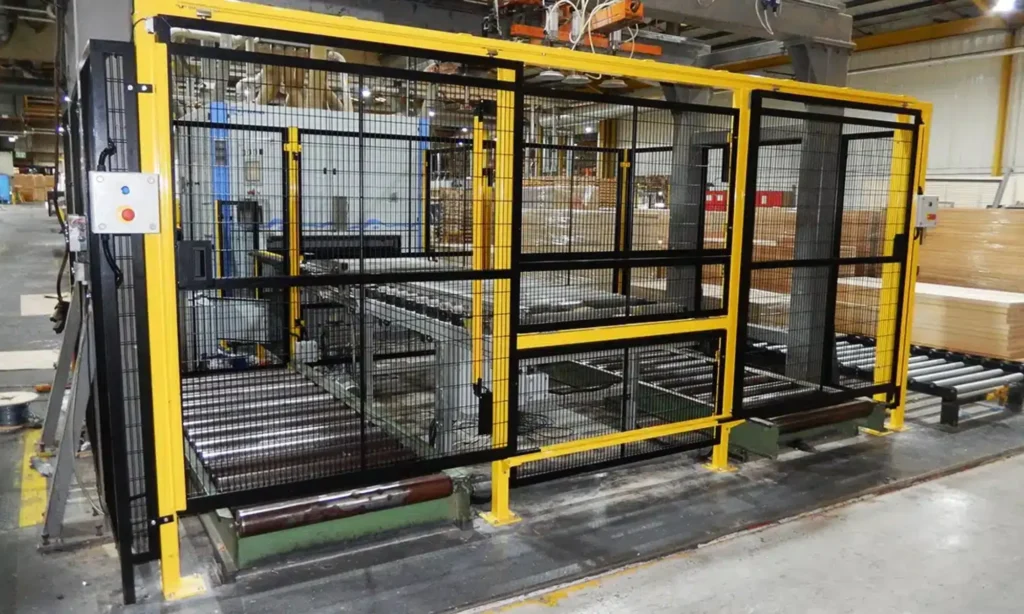
Benefits of Interlocked Guards
Why go through the trouble of wiring up doors and inventing complex locks just to guard a machine? It turns out that interlocked guards bring huge benefits to industrial operations – not just in safety (though that’s number one), but also in efficiency and compliance. Here are some key benefits:
1. Dramatically Improved Safety
First and foremost, interlocked guards prevent a lot of accidents. By ensuring that hazardous parts are either stopped or inaccessible whenever a person could reach them, these systems mitigate the risk of accidental contact with things like spinning blades, pinch points, or high-voltage components.
They also reduce human error; even if someone forgets to hit the stop button before opening a gate, the interlock has their back and stops the machine for them. This greatly lowers the chance of injuries and gives workers and safety officers peace of mind. It’s like having an automatic fail-safe – the machine cannot hurt you in the usual ways if the guard is open, because it simply won’t run.
2. Prevention of Unauthorized Access and Bypassing
Interlocked guards act like steadfast security guards (pun intended). Only authorized or trained individuals should be accessing certain areas, and interlocks help enforce that. For example, you might need a specific key or an access card to engage the interlock and open the gate, ensuring only the right people get in. Even beyond personnel, the interlock itself discourages tampering or bypassing – it’s not easy to “cheat” a well-designed interlock without triggering an alarm or shutdown.
By making it physically and electronically difficult to bypass safety measures, interlocked guards create a more secure work environment. This means fewer opportunities for an impulsive shortcut or a reckless act to result in disaster. It encourages everyone to follow proper procedures because the machine simply won’t cooperate with unsafe actions.
3. Maintaining Efficiency and Uptime
Surprisingly to some, safety interlocks can increase operational efficiency when used correctly. How? They ensure that machines only run when conditions are correct, which can prevent costly mistakes and damage. They also can be designed to allow quick access for maintenance without entirely dismantling safety guards.
For instance, instead of unscrewing a fixed cover (which takes time and then time again to put back), an interlocked door can be opened in seconds once the machine is safe, and the system knows to keep things off until you’re done. This can minimize downtime when clearing jams or performing adjustments.
Modern interlocked guards often allow for safety in a workflow-friendly way – you can open a gate, fix a minor issue, and get the machine running again quickly, all while staying protected. In contrast, older methods like fixed guards might require more downtime to remove and replace covers. In short, well-implemented interlocks strike a balance between safety and productivity, ensuring efficient operations without compromising worker well-being.
4. Regulatory Compliance and Avoiding Trouble
In many industries, using interlocked guards isn’t just a smart choice – it’s the law (or pretty close to it). Safety standards from organizations like OSHA (Occupational Safety and Health Administration) and international bodies (ISO, IEC, etc.) often mandate or strongly encourage interlocked guarding for certain hazardous machines.
By implementing interlocks, companies demonstrate compliance with these safety regulations, which can save them from legal penalties, fines, or shutdowns. It also protects the company’s reputation – nobody wants to be known for a preventable accident. Knowing and following standards (like OSHA’s machine guarding requirements or ISO 14119 for interlocking devices) is much easier when you have the right hardware in place.
So beyond protecting people, interlocked guards also protect the business – keeping the operation on the right side of the law and running smoothly rather than dealing with accidents and investigations. It’s truly a win-win: safe workers and a safeguarded company.
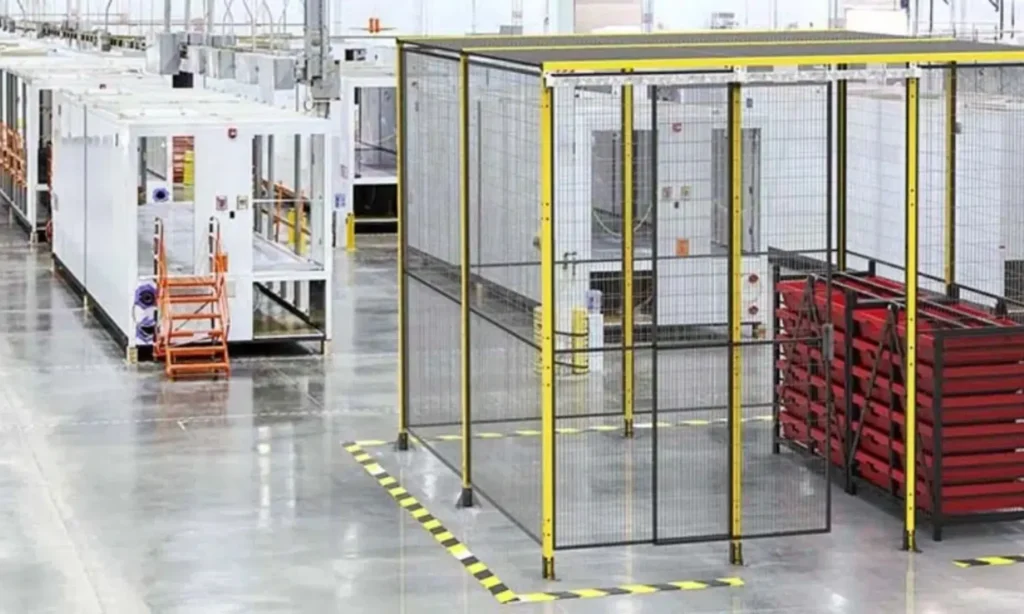
Common Applications of Interlocked Guards
Interlocked guards show up anywhere humans and hazardous machines intersect – which is to say, just about every industry that uses heavy equipment or automation. Here are some common applications and examples where interlocked guards are found keeping things safe:
An interlocked guard on an industrial machine. A transparent safety door is closed over the machinery’s working area, and a sensor or lock ensures the machine stops if the door opens. Such guards are commonplace in factories to protect operators from moving parts.
1. Manufacturing and Assembly Lines
Walk into any car factory, packaging plant, or general manufacturing facility and you’ll see interlocked guards all over. They protect workers from heavy machinery, conveyors, gears, and presses. For instance, a conveyor might have an interlocked gate so that if someone opens it to clear a jam, the whole line shuts off. Assembly line robots are typically fenced off with interlocked gates – open the gate and the robots lose power immediately.
In metalworking or woodworking shops, machines like presses and CNC mills have interlocked doors or covers so you can’t reach the cutting tool while it’s spinning. These setups are so common because they effectively prevent countless accidents on fast-moving production lines.
2. Robotics and Automation Cells
Industrial robots can be awesome to watch – less awesome if one whacks into you. That’s why robot work cells (those caged areas where robot arms weld, paint, or move parts) use interlocked guards extensively. Typically, there’s a fenced enclosure with one or more access doors, all interlocked. If a human needs to enter the robot cell (for maintenance or part clearing), they usually have to request access which stops the robot, and only then a door can be unlocked.
The robot won’t start up again until the door is closed and a safe start sequence is followed. This prevents those dramatic (and dangerous) human-robot encounters. Even smaller collaborative robots, which are designed to work near people, use interlock devices for certain higher-risk operations.
Automation systems often integrate light curtains (if you break the invisible beam by stepping in, the robot stops) – that’s a form of interlock too. In short, anywhere you see a robot fenced in, you can bet an interlock is keeping it from turning into a metal dance partner when you step inside.
3. Power and Energy Equipment
High-voltage or high-power equipment often requires interlocked access panels. In electrical substations or power generation plants, you’ll find interlock systems on things like switchgear cabinets, transformers, and high-voltage enclosures. The idea is straightforward: if a cabinet door is opened, the interlock makes sure the electricity is off (or cannot be turned on). This saves maintenance workers from the nasty surprise of touching live components.
In some designs, a special key system might require you to turn off the breaker and thereby release a key that then allows the door to open – a mechanical-electrical interlock combo. In other cases, a simple electrical interlock cuts power the moment the access panel is cracked open.
Similarly, industrial ovens and furnaces (think of big baking ovens or heat-treat furnaces in factories) use interlocks so you can’t open the door when the temperature is dangerously high, or the machine will shut off the burners if the door opens. This not only protects people from heat and flames but can also prevent explosions or fire by not feeding combustion when the chamber isn’t sealed. Essentially, interlocks in the power and energy realm protect against invisible dangers like electrical shock and thermal hazards.
4. Material Handling and Warehousing
Ever seen those big automated systems that move pallets around or the giant carousels that bring items to workers in a warehouse? These often have interlocked gates too. For example, a conveyor in a distribution center might have sections that only operate when safety gates are closed. If a box gets stuck and someone opens a gate to fix it, the interlock halts the conveyor to prevent the person from getting pulled in.
Automated guided vehicles (AGVs) and forklifts are increasingly safety-fied with interlocks – an AGV might not drive into a certain zone unless a gate sensor says it’s clear, or a forklift might have interlocks that limit speed if certain guards aren’t in place. In elevators or lifting equipment, interlocks are critical (imagine an elevator that could move with the door open – no thanks!). In short, any system where things are moving from point A to B and people might cross paths with that motion, interlocks step in to add a layer of control and awareness.
And that’s just a sampling. You’ll also find interlocked guards in food processing (for slicers, mixers, etc.), in pharmaceutical manufacturing (where cleanliness and safety combine – interlocks ensure machines stop both for safety and sometimes to maintain sterile conditions), and even in consumer products like some high-end laboratory equipment or commercial kitchen machines. Wherever there’s a hazardous motion or energy and a need for human access, interlocked guards are the go-to solution for keeping the two apart until the right time.
Innovations in Interlock Technology: Smarter, Safer, Future-Friendly
Interlocked guard systems aren’t stuck in the past – far from it. As technology advances, so do these safety devices, becoming smarter and more adaptable. A forward-thinking safety officer or engineer will want to know about the latest innovations in interlock technology, which range from high-tech sensors to internet-connected safety systems. Let’s highlight a few exciting developments:
1. RFID-Based Safety Interlocks (High-Tech Tags and Sensors)
We mentioned RFID interlocks earlier as a “type,” but it’s also a true innovation that’s been gaining ground in recent years. Older interlocks could sometimes be defeated by clever operators (like sticking a spare magnet on a magnetic switch, yikes!). RFID-based systems answer that by using uniquely coded tags and readers, so only the real guard in the right position will satisfy the system.
Modern RFID safety switches can have billions of possible codes. Practically, this means each gate or door has an electronic “key” that’s one-of-a-kind. The machine’s controller will recognize only that key. If someone tries to fool it with another sensor or by removing the tag, the machine stays off.
These RFID interlocks are also usually non-contact, which makes them highly reliable in dirty or wet environments (no exposed pins or levers to gunk up). They don’t require precise alignment like some old-school switches, so you get fewer nuisance shutdowns due to a slight door sag or vibration. In a nutshell, RFID interlocks are like giving your machine guard a smart ID card – no ID, no entry, and no start-up either.
The innovation here is better security and reliability without sacrificing convenience: maintenance folks can quickly open a door when needed (after stopping the machine safely, of course), and when they close it, the system immediately knows everything is legit and allows operations to resume. As RFID technology keeps improving, we’re seeing smaller sensors, longer sensing ranges, and even wireless options that reduce wiring complexity.
2. Programmable and “Smart” Interlock Systems
Traditional interlocks were hard-wired – meaning their logic was fixed by how they were connected. Today, we have programmable safety controllers and safety PLCs (Programmable Logic Controllers) that can handle interlock logic in software. This opens up a world of possibilities. With programmable interlocks, you can set up complex safety sequences.
For example, you could program a system such that opening Guard A only stops Machine X but not Machine Y, unless Guard B is also open – basically tailor the responses to your needs while still meeting safety principles. These systems often come with diagnostics and status information. Many modern interlock devices themselves have built-in microprocessors that communicate status to a central system. If a door is unlocked, a light on the HMI (Human-Machine Interface) might glow red and a message could display “Gate 3 Open – Robot Paused.”
Smart interlock controllers can be adjusted without rewiring – if you need to change how it works, you update the code or settings rather than calling in an electrician to move wires. Some innovations in this area even allow on-the-fly adjustments via user-friendly software. Importantly, these are safety-rated controls, meaning they’re designed and certified to be just as reliable (if not more) than the old hard-wired methods.
The benefit is flexibility: as factories adopt more automation and quick change-overs, having interlock systems that can adapt through programming is a huge plus. Imagine being able to reconfigure a production line and easily reprogram the safety interlocks to match – that’s increasingly a reality.
3. IoT Connectivity and Remote Monitoring
Yes, even machine guards are joining the Internet of Things (IoT). A cutting-edge trend is equipping safety interlock systems with connectivity so they can be monitored in real time and even send alerts. For instance, if someone leaves a safety gate open, not only does the machine stop, but a notification could pop up on a supervisor’s smartphone or central control room screen. This means no more wondering why Machine 5 is down – you’ll instantly know “Guard open at Station 5.” IoT-enabled interlocks can log data on how often gates are opened, or if someone is repeatedly attempting to bypass a guard, etc.
Additionally, they contribute to predictive maintenance: by monitoring the health of the interlock devices (sensors, switches) themselves, the system can warn if a particular interlock is starting to fail or has intermittent faults, allowing you to fix it before it creates a safety gap. In large facilities, wireless interlock systems are emerging, which use secure radio signals rather than long cable runs – handy for moving equipment or modular setups.
All this connectivity does require robust cybersecurity (you wouldn’t want someone hacking your safety systems!), and indeed manufacturers are now also focusing on the digital security of interlocks. Still, the result is a more transparent and responsive safety setup. Managers can see the status of all guards at a glance, maintenance can pinpoint issues faster, and the whole safety system becomes proactive rather than just reactive.
4. Enhanced User Interfaces and Integration
Another innovation is making safety systems more user-friendly. Newer interlock control units might have touchscreens or simple indicator dashboards that operators can easily read. For example, a screen might show a green outline for closed guards and a red highlight where one is open, making troubleshooting as easy as looking at a picture.
Integration with broader control systems (like SCADA or factory software) means interlocks aren’t in a silo – they work in concert with production. This allows smarter decisions; for instance, if a guard is open, the system can automatically ensure related machines are in safe states and maybe trigger a lock-out procedure or guide the operator with on-screen instructions.
There’s also a push for ergonomic and efficient guard designs (lighter materials, easier latching mechanisms) that encourage their use rather than tempting workers to cheat them. Some interlocks even have built-in delay timers or safety sensors – e.g., a door that won’t unlock until 30 seconds after hitting stop, to give a saw blade time to coast down – all configurable via software.
The tone of innovation here is making safety as seamless and foolproof as possible. The best interlock is one that the workers almost don’t notice (in the sense that it doesn’t frustrate them or slow them unnecessarily) yet always does its job. So newer systems focus on intuitive operation, quick reset after actuation, and clear feedback when something needs attention.
All these innovations boil down to a simple idea: keep improving safety without hindering productivity. RFID adds security, smart systems add flexibility, IoT adds awareness – together, they make interlocked guards more powerful and easier to use than ever. As we move into the future, we can expect even more clever safety features (perhaps AI-driven safety analysis, or interlocks that talk to each other across a whole facility to optimize safety in real time).
For safety officers and engineers, staying informed about these developments is key. Embracing modern interlock technologies means you’re not only keeping people safe today but also building a culture of safety that’s ready for tomorrow’s challenges. And hey, it gives you a great answer when someone asks, “What’s new in the safety world?” – you can say, “Our machines are so smart, they practically tweet me when someone forgets to close a gate!” (Just an example – maybe a bit of humor there, but not too far-fetched!)
Conclusion
Interlocked guards may not be the flashiest part of a factory or a robot cell, but they are undeniably the unsung heroes of workplace safety. These systems quietly (and sometimes not so quietly with alarms buzzing) ensure that humans and machines cooperate in a safe dance – no unexpected moves, no painful missteps.
We’ve seen that interlocked guards come in many forms, from simple mechanical keys to cutting-edge RFID locks, all serving the same noble purpose: stop the machine when danger is near, and only let it run when all is clear. For safety officers or junior engineers reading this, the take-home message is encouraging: investing time and effort into good interlock systems pays off with fewer accidents, better compliance with safety laws, and even smoother operations.
Staying a step ahead is part of a forward-thinking safety culture. That means keeping an eye on new developments – maybe your next machine upgrade will include an IoT-enabled interlock or a programmable safety controller that makes your life easier. Don’t be afraid of these innovations; manufacturers design them to enhance safety without making things overly complicated.
In fact, most modern interlocks are built to be as plug-and-play as possible, with user-friendly interfaces and robust fail-safes. And if all this talk of smart safety has you worried about complexity, remember that at their core, interlocked guards follow a very straightforward principle: if it’s not safe, the machine won’t run. That simplicity remains, even as the tech around it improves.
In a slightly humorous light, you might say an interlocked guard is like a responsible friend who won’t let you drive off without your seatbelt on – a bit persistent at times, but only because it cares. And truly, in industrial settings, that kind of caring saves limbs and lives. So embrace interlocked guards with humility and confidence. Use them, maintain them, and always consider them in your safety planning. Encourage your team to appreciate these devices rather than see them as obstacles.
After all, the best innovations in safety are the ones that protect us while empowering us to do our jobs well. With interlocked guards watching our backs (and our fingers), we can push forward into ever more advanced and automated industries, secure in the knowledge that our clever safety systems are keeping pace with our ambitions. Stay safe, stay curious, and keep those guards interlocked – the future is bright and safe when we combine smart technology with best safety practices!

